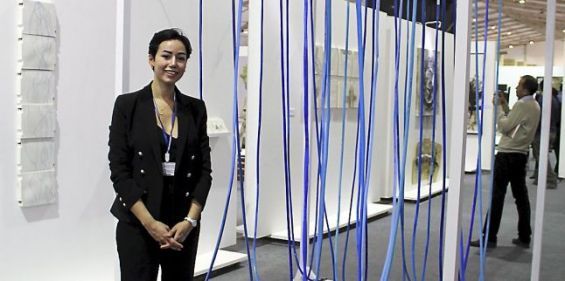«This painting is about war. And we live in one». This is how Nissrine Seffar describes the «Guernica», a painting by Pablo Picasso that denounced the maneuvers of Nazis and Fascist troops in Spain in the 30's. Following the path of the founding father of Cubism, the French-Moroccan painter has been working on her paintings since 2010, crisscrossing the Mediterranean that has been shaken by several uprisings. Today, she was chosen by the French Institute in Spain to celebrate Picasso's anti-war painting through her exhibition «Guernica Huella».
«I worked in particular on the bombing of Guernica, the city where I stayed. I thought of creating something that has the same dimension, through my vision and the look with which I interpreted Picasso's painting».
Born in Casablanca, and daughter to a father who met her mother as a tourist, Nissrine Seffar lived in Morocco until she was 28 years old. In 2011, she left for France which she considers now as a second home. There she moved to Sète, a coastal city that embrassed the young artist and allowed her to get two workshops, thanks to the town's hall.

An innate passion
Before traveling to Seville to render homage to Picasso, Nissrine Seffar took her first steps in painting as a child. «I remember that I have always expressed my passion through art. When I was 4 years old, I drew and sketched everywhere. Ten years later, I joined art classes and I knew my career was there».
A disciple of Moroccan artist Taoufik Mdeghri Alaoui, she was quickly spotted by him as a painter-born. «You were with me for years but you have never done something similar to this». The professor had commented on the first homework of the young artist in front of her classmates, on her first day at school.
The teacher was so struck by the genius of the artist that he asked her parents to stop paying for the classes. She was so passionate about painting that she spent the weekends in her teacher's studio, drawing and practicing on the canvas.
Years later, the young woman carried her studies at the School of Arts in Morocco and France. «A few years later, my father told me that he wanted me to move forward by following my passion», recalls Nissrine, who could always count with her parents' support. «He asked me to travel to other countries, to evolve before coming back».
Homesick
Nissrine left Morocco in 2011 feeling like a fish out of water. Homesick, the young artist was able to come back and show her work to local artists. Seeing the glass half full, the artist considers this as «an experience that made me learn. In Morocco, the means are lacking and there is almost no encouragement for young people who are dreaming to produce in this country. It hurts to leave my country but it allowed me to boost my skills and evolve artistically-speaking».

It is with good faith that the artist criticizes the lack of support for painters and visual artists at the beginning of their career in Morocco, because she believes that it is important to shed light on those who embody the future.
«Young people are the future of our societies. You have to support them because they make this country prosper. That's why I would never give up on my country despite the constraints.»
Recognition here and elsewhere
While she is exhibiting her work in Sevilla, Nissrine Seffar will have her paintings this month in Dar El Kitab in Casablanca. This is not the first time that she presents her work of art as a professional artist in her hometown, since she recently received the 1st Young Contemporary Artist Award at the Venice Cadre Galerie (Casablanca). «This is a recognition for me and I am grateful to those who help me show my work to my people», says the artist.
«In Sète, the town hall made two workshops available to me», says the young woman who was granted French citizenship in 2017. «It is a country that supports me a lot. Deputy mayors are very responsive and they pay great attention to my work. I see this country as a second home for me».

Hoping that her work could constitute a bridge between France and Morocco and across the Mediterranean, Nissrine Seffar wants to join poetic value and political orientation, through a painting engaged in research, exploring ways to unite people in the region.
«Art is freedom of expression. We can send a lot of strong messages, artistically. It is normal that art embodies freedom», she concludes.
Working tirelessly, Nissrine Seffar finds rest and fulfilment in creation and research. At the moment, her exhibition paying tribute to Guernica reveals a great success, the painter is already planning another exhibition, this time retracing the Hiroshima bombings.





 chargement...
chargement...













